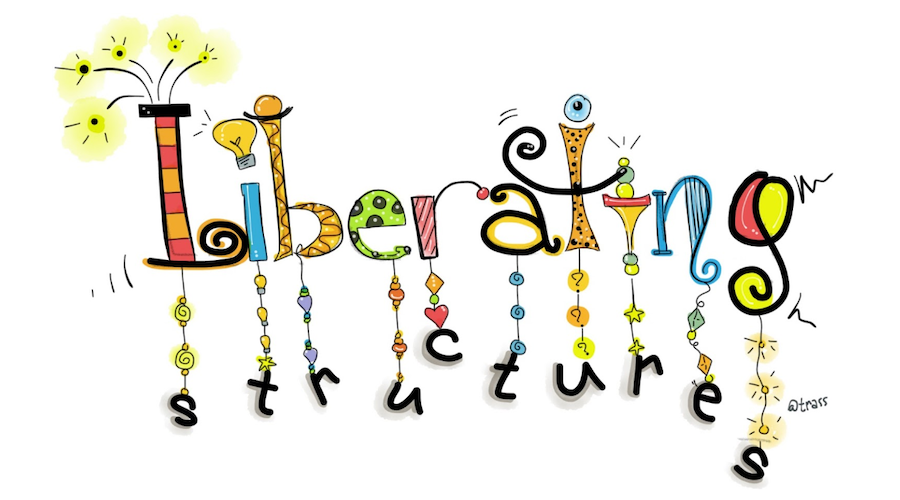Liberating Structures: Giving Everybody an Equal Voice
“It was astonishing how a day on Zoom could be so energising, interesting and engaging.”
Since their introduction in mid-2020, our online Liberating Structures Immersion Workshops have consistently rated among the most engaging events we've ever held.
Imagine if every meeting or event that you attended gave every participant the chance to speak and to express their views. That is what is made possible by Liberating Structures, 33 methods that avoid one person dominating and instead give everybody a voice.
If you want your online events to be truly interactive, this could be the place to start. In this blog, Henry Stewart offers a summary of eight Liberating Structures.
Hi, we are Happy
We are leading a movement to create happy, empowered and productive workplaces.
How can we help you and your people to find joy in at least 80% of your work?

Impromptu Networking: Getting to know people
- Grouping: Pairs, three times
- Prompt: Same prompt each time, What do you see emerging out of the crisis?
- Timing: 4 mins for each pair, three times
Impromptu Networking puts you in a pair, three times, to explore a question. It is a great start to the day, to meet some people and examine a key issue for the session. As you are in pairs, everybody gets to speak.
This is one place where online can make it easier to meet people. No awkward introductions, you just get placed in a breakout with somebody.
- “Very natural to do it online, which i didn't think it would be.”
- “Agree. Way less awkward!”
- “Something Ruth said struck me: The emotional response in the 3rd cycle was much deeper and she found things she didn't know were there.”
Nine Whys:
- Grouping: On own, then in pairs
- Prompt: What do you do in your work, what is important to you
- Timing: 4 mins, 2 x 5 mins, asking “why do you do X?”, “why is this important to you?”, “what does X make possible?”, delving deeper
Nine Whys enables you – by being asked repeated Whys - to probe deeply into what really matters to you, in a relatively short space of time.
We ended by answering the question “My work exists in order to …”. The person I was with said she’d never seen it in the way she had in the session before and it was a revelation. All in 14 minutes.
- “Wow! Feel a bit emotional now!!”
- “That was beautiful!”
- “Created a safe space to have a deeper conversation”
TRIZ: Using an anti-problem for inventive problem solving
- Grouping: On own, in pairs, in fours
- Prompt: What could cause [worst possible outcome]
- Timing: List what could cause disaster, identify current practices which resemble those, identify how to stop doing them
TRIZ is always good fun. You explore something you need to achieve (eg, how to make this project succeed) by taking the anti-problem (how to make this project fail badly) and see what would create that. Its remarkable how often the elements that would create the worst result are happening at the moment.
It creates humour as you look at ridiculous ideas and moments of clarity as you realise some of the actions your organisation is pursuing lead directly to the worst outcome.
- “that was intense”
- “Allows participants to identify dysfunctional patterns of behaviour and take responsibility for changing them”
- “moves from a passive problem saturated place to an active problem solving”
Appreciative Interviews:
- Grouping: On own, in pairs, in fours
- Prompt: Identify success story, after facing challenge
Timing: Identify story (2 mins), share with colleague (2 x 4 mins), colleague then shares your story in four (4 x 2 mins), identify success factors (7 mins), collate success factors (10 mins)
Appreciative Interviews could be seen as the opposite of TRIZ. Where have you succeeded and what were the success factors that enabled that to happen.
We put the success factors on Jamboard (Google’s free post-it tool), putting people on the same board as their room number and then used Slido to bring the concepts together, first as a Word Cloud and then by voting up the various Success Factors.
What had enabled success in the crisis? “Relationships that enable collaboration and trust”; “Resilience and trust in yourself”; “Clarity of purpose”; “Strength with vulnerability”.
“energising, great for team cohesion”
“Enabled a link between personal experience and identifying success factors … very grounded”
“It enables an insight into value bases for people and why something is deemed successful”
Mad Tea (chat version): Everyone’s View Instantly
- Grouping: Answer on own in chat
- Prompt: Series of prompts, for each person to answer in chat
- Timing: Around 1 min per prompt
Most of the Liberating Structures need breakouts to work online, using a package like Zoom. However Mad Tea (chat version) only requires a chat room and so can be used in virtually any piece of conferencing software.
Ask a question, ask people not to press Return for the moment, wait until everybody has answered and then get them to press Return together. Explore the range of answers and then move on to the next ones. Examples include “This morning has left me feeling…”, “A new thing I am learning about myself is….”, “Something important I’ve noticed is ….”
- “Really quick way of gathering lots of information”
- “a great energiser or icebreaker”
- “Lovely rush, chance to see range of perspectives”
- “Love this as a way of getting engagement from a group of delegates”
Min Specs:
- Grouping: On own, then pair then four
- Prompt: No going back: what are the MUST Dos and MUST NOT Dos to emerge from the crisis in the best possible way?
- Timing: Generate max specs (5 mins), test each rule (10 mins then 5 ins more), compile min specs (3 mins)
Think of all the rules that could apply, and then cut them down to the absolute minimum.
I gave the example of the Hyatt Hotel that used to have 24 rules for booking in a client. They replaced it with one principle – treat our clients as you would a guest in your own home – and saw customer satisfaction increase by 70%.
Inspired by this, one of the groups did manage to get down to just one rule.
- “to make plans more concrete, tangible and doable”
- “working out what really matters”
- “objective way of evaluating ideas, instead of the loudest person getting own way”
Troika Consulting: Instant practical help from colleagues
- Grouping: Threes in breakouts
- Prompt: Choose a challenge that faces you at the moment
- Timing: Client explains challenge (1 min), consultants ask question (2 mins), consultancy (4 mins), client feeds back (1 min). x3 to cover all involved.
This is a simple process that regularly produces remarkable results. Each person in the three poses a challenge. In real life people then turn their back. Online, you can turn your screen off.
You then get to hear two strangers exploring your issue. Again and again people report back that it produced real insights.
- "that was amazing"
- "That was so meaningful and special"
- "Its is just so enlightening listening to people talk about your challenge whilst youy just listen"
- "Excellent approach for opening eyes too new perspectives"
Conversation Café
- Grouping: 4 – 7 in breakouts
- Prompt: What are your reflections on today, what will you take forward into your work
- Timing: 4 rounds: 1st: Talk in turns about question, 2nd: follow up and elaborate, 3rd: open discussion, 4th: what taking away from conversation (1st, 2nd, 4th round taking it in turns)
Conversation cafe is one of my absolute favourite structures. Over four rounds, taking it in turns to speak always seems to produce some deep reflection. It is the best way I know to close a conference, ensuring that people embed what they have learnt and think about next actions.
In real life this is done with a talking stick. Online you simply form breakouts and mute everybody except one person. After they have given their view, they hand over to somebody else.
- "really useful to ensure that everyone gets space to contribute"
- "Allows everyone to express their opinions and not hide behind the louder people"
- "lovely synergy between individual and shared reflection which can fuel a deep and creative conversation"
- "nourishing - like that word."
Overall
And we closed with a virtual social, where people could move between breakout rooms called "snug" or "saloon" or "playroom". (In Zoom you can achieve this by making everybody a co-host, who - once allocated a room - can move to a different one.)
People talked about how inspired and energised they were, by using these straightforward structures to involve everybody.
My thanks to the other members of the workshop design team: David Heath, Leah Lockhart, Lyse Edwards and Mikala Ritzau for their excellent co-facilitation. For a Workshop to run this well takes careful pre-planning.
Keep informed about happy workplaces
Sign up to Henry's monthly Happy Manifesto newsletter, full of tips and inspiration to help you to create a happy, engaged workplace.

Learn the 10 core principles to create a happy and productive workplace in Henry Stewart's book, The Happy Manifesto.
Henry's Most Popular Blogs
- 8 Companies That Celebrate Mistakes
- 9 Benefits of Having Happy Employees
- 321Zero: How I Solved my Email Overload
- 16 Companies That Don't Have Managers
- 5 Big Companies Who Swear by Mindfulness
- 49 Steps to a Happy Workplace
- A Four Day Week? Let's Start With a Four Day August
- Google: Hire Great People and Give Them Lots of Autonomy
- Buurtzorg: No Managers, Just Great Care From a Nurse-Led Service
- 30 Steps to Joy at Work: Get More Done by Being Less Busy
Learn more Liberating Structures with our workshops
- Using Liberating Structures (learn 4 structures)
- Introduction to Liberating Structures (6 structures)
- Liberating Structures Immersion Workshop (8 to 10 structures)
Learn how to use Liberating Structures at our workshops
We offer two Liberating Structures workshops, held in partnership with LS London:
Using Liberating Structures Online is a perfect introduction to the Structures. It's just 2.5 hours long and held remotely through Zoom. It's perfect if you have never used Liberating Structures before. Our next public workshops are on 10th June and 15th October 2025.
In our Liberating Structures Immersion Workshop, you will gain hands-on experience of using at least eight of the Structures. This one-day workshop will be held online via Zoom on 5th August, and in the classroom at Happy on 14th May.
Why learn online with Happy?
- Interactive and engaging - just like our classroom sessions
- Bitesize or full-day sessions - fit around your schedule
- Learn from home - all you need is a quiet place to call from and an internet connection
- IT Helpline - 2 years of free support after your course
- No quibble money-back guarantee

Henry Stewart, Founder and Chief Happiness Officer
Henry is founder and Chief Happiness Officer of Happy Ltd, originally set up as Happy Computers in 1987. Inspired by Ricardo Semler’s book Maverick, he has built a company which has won multiple awards for some of the best customer service in the country and being one of the UK’s best places to work.
Henry was listed in the Guru Radar of the Thinkers 50 list of the most influential management thinkers in the world. "He is one of the thinkers who we believe will shape the future of business," explained list compiler Stuart Crainer.
His first book, Relax, was published in 2009. His second book, the Happy Manifesto, was published in 2013 and was short-listed for Business Book of the Year.
You can find Henry on LinkedIn and follow @happyhenry on Twitter.


